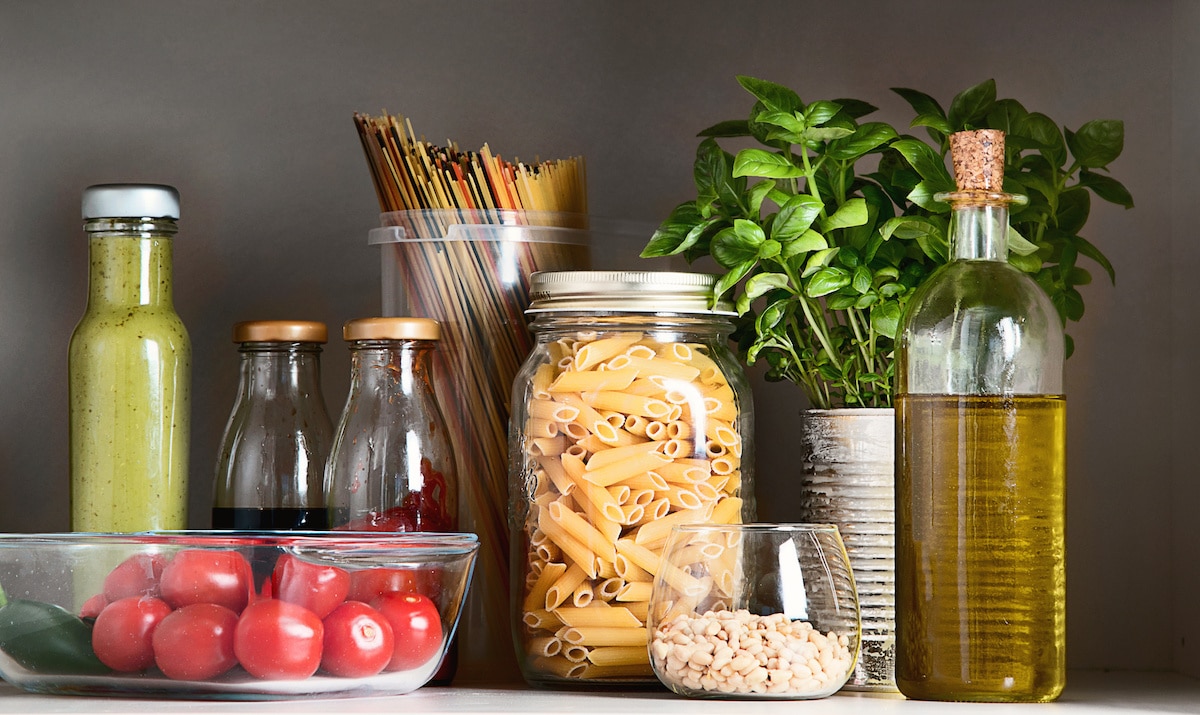Whether you’re heading out for a long road trip or a short camping trip lasting for a weekend or longer, you’re going to want a well-stocked camping pantry. You may be thinking you must bring a camping cooler to store meats, beverages, and produce items, but that’s not exactly what we’re talking about. There’s a bit of wiggle room here, which we’ll clear up later on.
What We'll Cover
In this guide, we’ll cover what a camping pantry is, or should be, and how to stock yours properly for short or long excursions into the great outdoors.
What is a Camping Pantry?
Your camping pantry is your collection of all the food you bring with you while camping. It should supply you on the road to and from your camping destination, and tidily serve everyone in your party at camp.
As mentioned above, it may include meats, fruits and veggies, beverages and other things that you want to keep cold. For general considerations, that is your camping cooler. It’s not necessarily part of your pantry, per-se, which is for the many in-between things that are either non-perishable or less perishable than the things you want to keep on (or near) ice.
Now, when you look at the items in your cooler, you have the main ingredients for the bulk of your main meals. By contrast, the items in your pantry are what will make the difference between one type of meal and another. It is your spices, flavorings, sauces, bread, side items and the like. The spices you bring camping will help you keep some variety in your diet while camping.
Many of the things in your pantry will have the added value of serving as good backup food items if your meats and other perishable things go bad. Your pantry will not only provide you with variety and flavor, but it’s also a good way to pack in some food security in the event that your main supply is compromised.
The three things you should expect to get out of your camping pantry are:
- The right amount of nutrition to comfortably sustain you
- Storage items to maintain your supply between meals
- Secure, sealable primary storage containers
Stocking Your Camping Pantry
Your pantry is going to be made up of things that can be a light snack, a semi-long term food security item, or for use as flavoring, spice, etc. These are mostly things that can be stored at room temperature, as long as the temperature of the room stays reasonably mild. Some meats can go in your pantry if properly stored, which we’ll get into in more depth in a moment.
Snacks
Common camping pantry items include popcorn, chips, crackers, trail mix, protein bars, and the like. They should mostly be things that bugs could not get into even if they wanted to – and they do. These are items you’ll want to jam into your backpack during a hike or to just grab in-between meals.
Try to avoid the temptation to bring too many candy items and nutrition-poor foods. Potato chips and candy bars can be delicious and fun to eat, but they will leave you drained on those long hikes. If you have too many treats during your trip, you may feel ill on your way home. This can leave you undernourished, hypo or hyperglycemic – and leave you with a diminished sense of fondness about your trip.
Focus on bringing nutrient-dense snack items like protein bars. Fitness snacks are always better than candy bars, but many of them are far-less healthy than the packaging suggests. If you do bring fun foods, try to save them for the evenings when you’re relaxing by the campfire. Don’t eat candy on the hiking trail.
Herbs, Spices, and Seasonings
Your pantry will also include special herbs, spices, and seasonings to help round out meals and to complete certain recipes. They include salt, pepper, thyme, rosemary, sage, seasoning mixes, rubs, garlic powder, fresh garlic, etc. These items are a great way to get the most out of the foods you do bring. Make sure you pack in enough flavor to satisfy your palate in camping spice containers; otherwise, you may find yourself tempted by that candy bar we talked about.
Meats
Your pantry can also include meats like beef, chicken, turkey, lamb, and fish. Generally, these types of items should be kept on ice in a container separate from your pantry. However, if the chiller compartment of your overall food storage scheme is part of your total pantry, then let’s not get bogged down with definitions. The important thing to remember is meats must be properly chilled and kept separate from other food items before preparation.
If you don’t feel confident in your ability to store meats and cook them safely, then you might consider going without them. If you’re just car camping, or only having a one-night outing, smoked or dry meats might do the trick. If you want to go without meats entirely, a can of mixed nuts will give you lots of protein. Plus, it’s highly unlikely that a can of salted nuts will go bad any time soon.
Dried Foods
Your pantry will also include dried foods such as pasta, noodles, rice, beans, etc. These are great for adding texture to meats, generating extra variety, and they are long-lasting in storage.
If you’re not a whiz in the kitchen, or if you don’t have space or a camping kitchen organizer to properly store a complex collection of food items, then dried foods and dry food can be your best friend. If having complicated meals isn’t your highest priority while camping, dry foods are a great way to keep your belly full and keep you going throughout your trip.
Supplies
Every camping pantry also needs a number of storage supplies. These include utensils, aluminum foil, plastic wrap, tupperware, and so on. Because space is at a premium, you want to bring things that will become storage or will collapse after setting up your camping kitchen. This is why we recommend using frozen water bottles to chill meats, for example. If you use tupperware, try to select sets that fit together nicely to save space after they are used.
You might want to boil some water to sterilize used pots, pans, and containers. Otherwise, your return trip might get a bit smelly. Bringing a handful of trash bags is a good idea. You can use these to contain any unclean dishes or containers you may have. You can also throw anything in them that gets dirty, which is difficult to clean at camp.
Please, do not use bodies of water to clean your dishes or cookware. Try to avoid letting the runoff from your cleanup stay on the ground. If food items do get on the ground, it’s best to bury them, or pack them away in your trash bags. Leaving any open food around, even a small amount, can attract dangerous animals, vermin, and make the campground less enjoyable for the next people to use it.
As always, it’s nice to leave our great outdoors looking as good as when you arrived, or better.
Saving Space: Bring Only as Much as You Need
Unless you have a great big convoy trucking through the night, you’re going to be working with limited space. This means you’ll have to judiciously select what you bring and what you don’t. With any camping trip, it’s best to only bring the exact amount of food you’ll need and no more. This is how to avoid the risk of accidentally littering, and incurring the many hazards of foodborne illness.
- Use small reusable bottles for sauces and condiments instead of bringing the entire bottle.
- Only bring enough bread for the meals you intend to have during your trip.
- Mix spices for specific dishes at home and put them in separate baggies or mix with food to marinate.
The best way to do this is to plan each meal specifically. Know how much of each ingredient you will use for each meal and pack only the amount you intend to use. This will help you avoid ending up with mismatched leftovers, like half a can of unused beans, uneaten produce slices, and other unfortunate leftovers that can cause a mess, attract bugs, or simply go to waste.
Maybe you’re not a foody, and you’re put off by the idea of planning each and every meal out with military precision. Maybe you’re too busy thinking about the hike, the hunt, the photography, or the sightseeing you intend to do out there in the great wide open. That’s no problem. If you’re not a whiz in the kitchen, planning meals out precisely can seem like an overwhelming endeavor. We think you’ll find it easier than you anticipate if you put a little planning into it. But, remember, you can always get by on simple dry-storage items, like protein bars, dried fruits, nuts, jerky and the like.
It’s also important to keep in mind there may not be any trash receptacles near your campsite. This means you may have to pack your trash for some time. The more trash you have, the more it will develop mold and fungus, attract bugs, and produce unpleasant smells. Minimizing your trash means minimizing your discomfort – as well as reducing the likelihood that you’ll be tempted to litter, not that you would.
Store Cold Food Separately
Because it’s so important to store meats and other cold food in cold storage, we would tend to think of these as separate from your camping pantry. But again, whether or not you store these things in a common area with your dry, non-perishable, and semi-perishable foods, the important thing is to keep them in fully sealed, cold, and secure containers.
Conclusion
Your food pantry is your key to enjoying your camping expedition. You need it packed well not only for the benefit of good food, but also for basic camping hygiene and safety. Pack yours well, and it will serve you well.
The responses below are not provided, commissioned, reviewed, approved, or otherwise endorsed by any financial entity or advertiser. It is not the advertiser’s responsibility to ensure all posts and/or questions are answered.


![Tips to Go Camping With a Toddler [Different Weather]](/assets/images/375a17532f44c72a41d33b1008823cf3.png)


